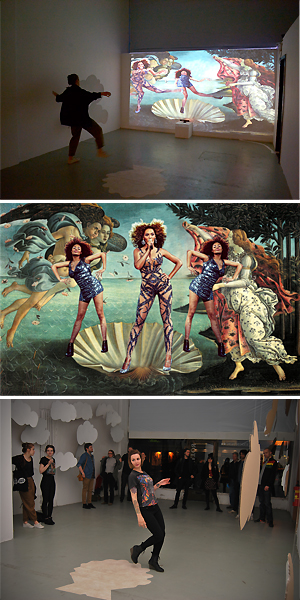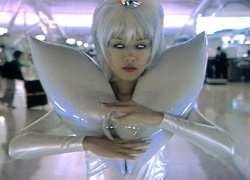User:Dennis van Vreden/proposal1: Difference between revisions
No edit summary |
No edit summary |
||
| Line 42: | Line 42: | ||
There was a moment in this episode where Beyoncé first mentioned her alter ego Sasha. This short moment of the mind and body when adrenaline takes over and a transformation takes place. The nerves introduce the moment, and the transformation is activated when the music begins. Then the performing beast takes over. | There was a moment in this episode where Beyoncé first mentioned her alter ego Sasha. This short moment of the mind and body when adrenaline takes over and a transformation takes place. The nerves introduce the moment, and the transformation is activated when the music begins. Then the performing beast takes over. | ||
After only a few more mentions of the Sasha persona, in 2008 the studio album "I Am... Sasha Fierce" was released. Making Sasha into the product it was meant to be. The album makes a two disc divide, a Beyoncé and a Sasha side. [[Image:morikomori.jpg|right|250px]] | |||
After only a few more mentions of the Sasha persona, in 2008 the studio album "I Am... Sasha Fierce" was released. Making Sasha into the product it was meant to be. The album makes a two disc divide, a Beyoncé and a Sasha side. Sasha being the extravagant performer side, and Beyoncé being the soft, intimate and personal side, naturally. | [[Image:kotaezawa.jpg|right|250px]]Sasha being the extravagant performer side, and Beyoncé being the soft, intimate and personal side, naturally. | ||
Revision as of 13:50, 30 October 2012
The Self Is Absent
The Abstract
The work I will be making this year will focus on the notions of escapism, time and cuteness.
The Practice
Recurring themes in my work have been identity, gender, the body and pop culture. Each project always begins with a certain fascination for certain behavioural patterns people have.
I am interested in the stage. The affect of it. The stage gives the opportunity to transform and it is that short transformative moment that fascinates me. The work I did last year is an example of that.
The Wonderful Media Design Technicolor Experience and ビヨンセ! Biyonse are two interactive installations. Both the installations The Wonderful Media Design Technicolor Experience and ビヨンセ! Biyonse had the same setup, but were different in topic. They were set up with a projection and a Kinect underneath it. They also both had music and a center spot facing the projection where the ‘user’ gets in the Kinects radius.
TWMDTE was exhibited for one day only, while Biyonse ran for five weeks in the gallery of Roodkapje in Rotterdam.
The installations used the Kinect to recognize the users skeletons and movement. The user enters the room not really knowing what will happen. As soon as they approach the center spots laid out in front of the projection the Kinect immediately reads the user and either Beyoncé (ビヨンセ! Biyonse) or Dorothy (TWMDTE) pops up in the screen and reacts to every movement of the user. The techniques that were used in the animation and Kinect were Processing and Animata.
TWMDTE was developed to coincide with the Musical Symposium that took place during the Open Day at the Piet Zwart Institute to represent the Media Design department. Biyonse was a follow up installation to see it in a gallery space and watch the response. There is something quite fascinating to see people react when all of a sudden whatever they do is reinterpreted by technology and acted out into a superstar.
Biyonse turned the gallery into a stage. Creating a center spot was mostly to send the visitor into the radius of the Kinect, but also functioned like the infamous 'Idols' spot where contestants were supposed to show their talents.
Biyonse explicitly invited the visitor to assume over the top poses to make the virtual Beyoncé respond to their movements in unnatural ways. A small movement is of course not of interest, but the Kinect requires some extremity in the skeleton to see a response. TWMDTE version was used in a more extreme way. Since Dorothy and the Wizard of Oz are such classics they were interesting to take to extreme movements that physically aren't possible. To fuck Dorothy up as much as possible. Beyoncé being a music artist therefore asks the visitor to actually dance. As if you are choreographing Beyoncé to do your bidding. Fucking her up also happens, but not like the Dorothy version. Of course the music acts as a huge catalyst for dancing. Beyoncé's being very up tempo. Dorothy's being quite slow (with music from the original soundtrack).
The Context
In Andy Warhol's Screen Tests I am fascinated by his interest in the personality of the person in front of his camera. It is an extensive research of behavior and mimicry. This corresponds with what fuels my work, which are behavioral patterns.
From watching the documentary Paris is Burning I became extremely interested in the drag queen culture. The documentary is a seven year project by Jennie Livingston and shows the lives of drag queens during the 80s in New York City and the society they created for themselves. It gives a great perspective on subculture. In my work there are often two layers. The extreme and affective layer, often Beyoncé related, and behind that there's the content. I am interested in how this relates to the drag culture. The flamboyant, extravagant outside is often overlooked as funny and superficial, but if can see beyond that, there are the most interesting stories.
In 2003 an MTV Diary video was broadcasted starring Beyoncé. This television series is about releasing information about the daily life of artists in a behind the scenes kind of way. Usually involving preparations for events like the MTV Video Music Awards or the Grammy's and behind the scenes footage of music video's.
There was a moment in this episode where Beyoncé first mentioned her alter ego Sasha. This short moment of the mind and body when adrenaline takes over and a transformation takes place. The nerves introduce the moment, and the transformation is activated when the music begins. Then the performing beast takes over.
Marina Abramovic has a similar feeling when she performs. In a 2009 interview with James Franco she speaks about the lower and higher self. The higher self being the state of mind she has while performing.
In a larger context, I am interested in the notion of escapism. Be that the way artists escape in their art. Or in the way the viewer, or the person that has the experience of the art, escapes. I have gotten a large amount of references from my tutorials with Thomson and Craighead including Moriko Mori and Kota Ezawa. Moriko Mori plays a lot with the aesthetic of anime and manga culture and Kota Ezawa makes works that completely flatten and reinvent video footages of famous television moments in a highly stylized pop art way, but keeping the audio. Allowing the viewer to completely reinterpret the content in an almost disturbing way.
The Plan
As a start, during the second term I will take an additional course at the Erasmus University. The course I will be doing is called Media and Cultural Globalisation and it will focus on the key role of media and media entertainment in the international spread of culture. As to say the impact of entertainment. My goal in this is to have a new perspective on my interest in popular cultural phenomenons such as Beyoncé and Korean Pop. I will also investigate what affect is and what it does by researching the work of Brian Massumi.
For the thesis I will be creating a film essay coinciding with a text. Similar to the short video essay I did last year about Modern Escapism (http://tinyurl.com/modernescapism).
Overall my working method has always been to work instinctively within my topics of interest and let it lead me.
The References
Marina Abramovic: The Artist Is Present
Beyoncé
Paris is Burning
Brian Massumi
Kota Ezawa
Moriko Mori



